When it comes to building any app, its future monetization is one of the most popular things people tend to search for. However, what people don’t always think about is complexity. The app monetization realm is packed with tiny nuances, different approaches, and various terms.
We understand how overwhelming this topic may seem, but the Codica team has covered you. With a solid experience under our belt, we are here to list practically every aspect of successful app monetization.
So, in this article, you will find out more about different subscription models, in-app purchases, in-app ads, and a lot more. We will cover their pros and cons, as well as the essential metrics you will need along the way.
What is app monetization?
Monetization in mobile apps represents the means by which developers and/or publishers are able to generate income based on their users’ activity.
Given that apps are estimated to reach $575+ million by 2025, this search term is becoming increasingly popular. Companies often refer to the app monetization strategy as the method to earn profit from their apps.
Why is it vital to realize how app monetization works, and what are its pressure points?
A properly thought-out monetization method can generate substantial revenue from a single app. Besides, a well-researched monetization strategy guarantees improvements not only in generating revenue but also in user experience, allowing you to strengthen your active traffic and attract more customers.
Apart from the actual choice, there are aspects you should care about as well. For instance, analytical data and different metrics are easily accessible and will allow you to track your app’s performance. There are lots of tools allowing you to monitor trends, see the number of downloads, and many other valuable metrics. Accordingly, new different app monetization strategies started to appear, allowing the app owners to get the maximum of the users' attention.
Free apps vs paid apps difference
The difference between free and paid apps is enormous in every application store. The circumstance, whether the user has to pay initially or doesn’t pay at all, causes both versions to feel like two separate realms.
As a result, each option leads to a different approach to mobile apps development and planning its content. Let’s take a look at the chart.
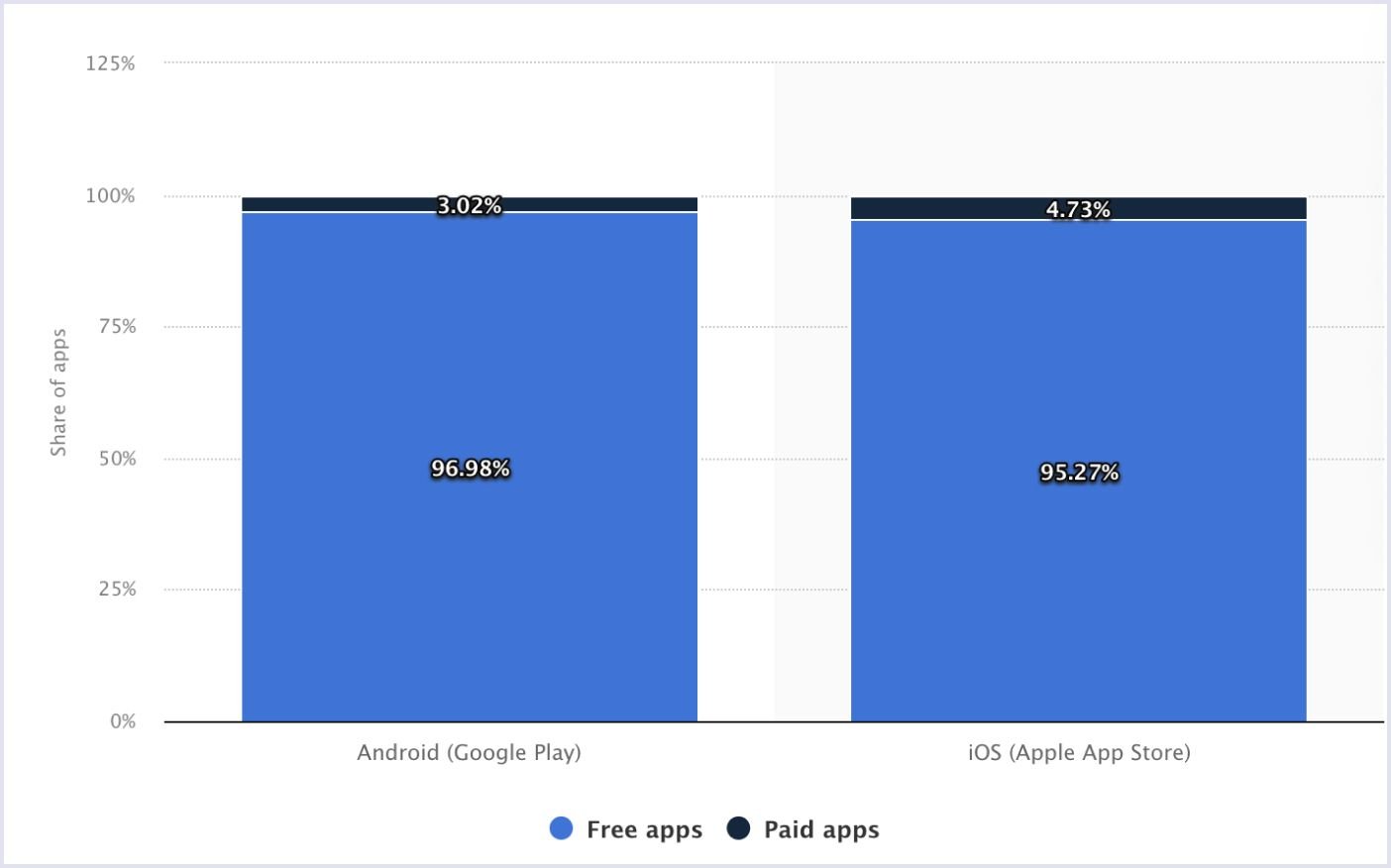
Source: Statista
As seen, free apps dominate the market with a spectacular 90%+ on both AppStore and Play Market. The paid app model is not popular at all.
There are several possible reasons for this. Let’s see what they are.
Focus on user engagement
That said, people would rather choose the free option than spend a few dollars. Making your mobile app available for free allows you to attract way more new users. Some of them probably won’t like your app, but they will at least give it a go and see if it matches their needs. In this matter, paid applications do worse, as the paywall obstructs regular user retention.
Finding the right balance
With different monetization apps, the right balance can be found in flexibility. That being said, the more different ad formats or models your app can implement the more effective user acquisition will be.
Given that the mobile app is initially free, you pack it with additional content later on, which is proven to be way more profitable.
On the contrary, asking people to pay a fair amount and then offering them additional content for more money feels greedy, to say the least. Thus, finding the right balance between free and paid options is crucial to successful app growth.
High competition
It’s much easier to succeed with a free app than a paid one due to recognition challenges. Only well-established brands can confidently launch paid apps, knowing users trust and value their products.
Paid apps often succeed by offering unique functionality, such as advanced tools for specialized fields like construction or chemistry. These apps can command prices between $5 and $20 due to their niche appeal.
Smaller companies typically focus on free apps, leveraging growth potential and alternative monetization strategies. Let’s explore these strategies next to identify the best fit for your business.
App monetization models
There are several models, and each particular one is suitable for each particular business type. However, with a great plan, they can also be combined in a hybrid app monetization strategy. Let’s look closer at models that app owners take advantage of today and figure out which one will suit your app type more.
Subscription-based monetization model
This is probably one of the most common models in modern applications. Generally, this type works fairly simply: it allows users to download the free app, use some of the functionality, and then logically lead them to the subscription.
In this model, a subscription is a monthly payment in exchange for the content or functionality.
The reason why subscription apps are so popular lies in giving app users the ability to try something for free and then decide whether they like it or not to proceed with the payment.
In Codica, we took advantage of the subscription model during a product discovery stage. The SaaS solution for bakery we built has a very neat monetization model. This platform connects cake makers and customers, eliminating unnecessary bureaucracy and administration. We thoroughly researched which model would be the most suitable for this particular type of business.
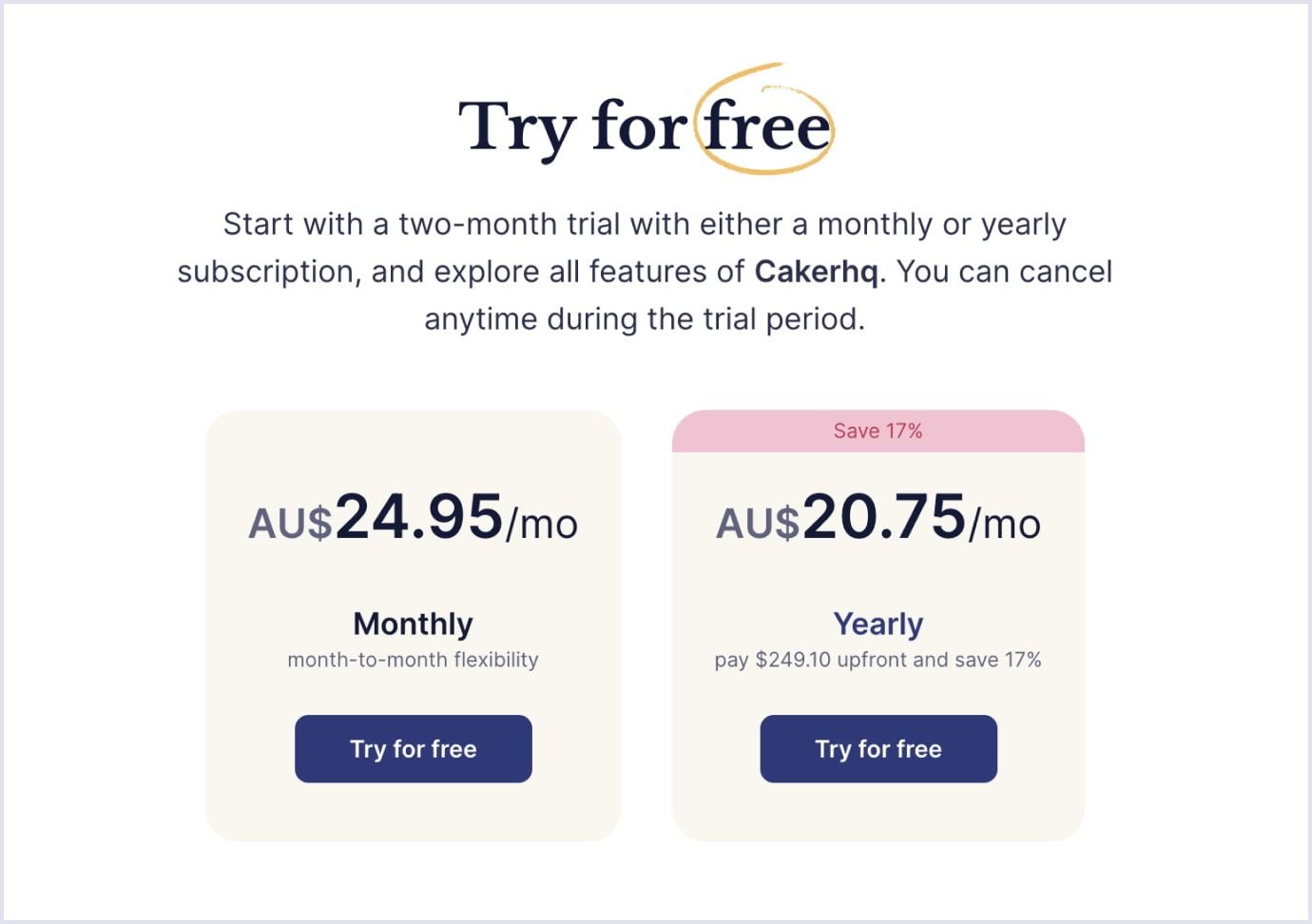
As a result, the platform offers two potential options.
It is either a free trial with a subscription for a month or a yearly subscription with a discount. Each option is suitable for different types of app users making the whole usage process versatile.
At its core, the subscription-based model is flexible as it has variables depending on the app's category, the content type, and the subscription duration.
For instance, many apps allow users to choose how many months they are willing to subscribe, offer a discount for longer terms, or provide different functionality for an extra price. Let’s cover the next type.
Multi-tier subscription
Flexibility in subscriptions is crucial as it helps cover more potential app users with different expense plans. However, the lower the price, the fewer options the platform offers.
For instance, Netflix offers various subscription plans. They differ depending on the price, the quality, and the resolution of the content.
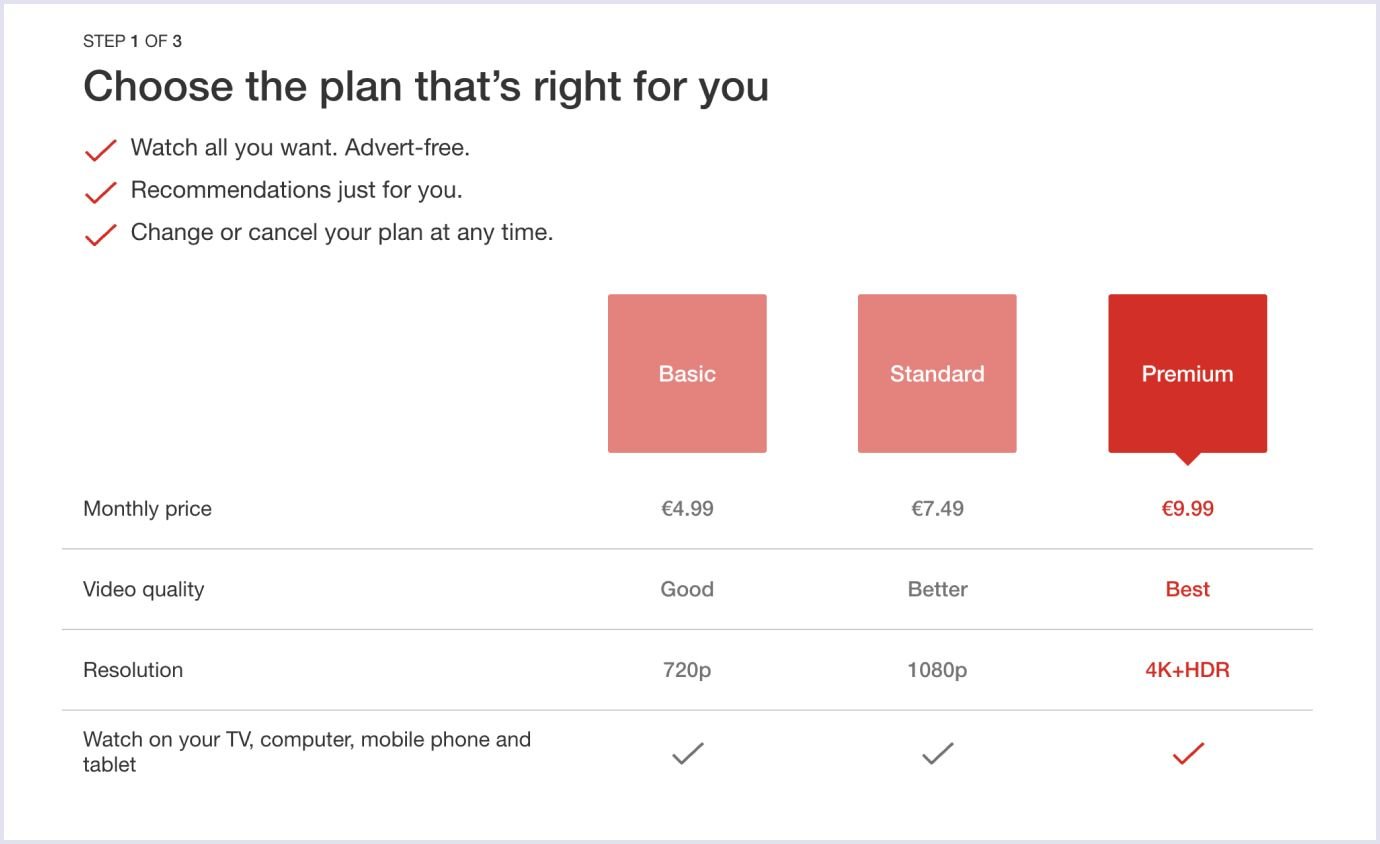
Source: Netflix
Freemium
The freemium app monetization model divides users into two following categories: free tier and premium tier, depending on whether they pay for their account or not.
Users who stick with the free app version still have access to the content. Yet it has restrictions like time limits, ad integrations, or inaccessible premium features.
Spotify, in this matter, is a prominent example of pushing the freemium model to the maximum.
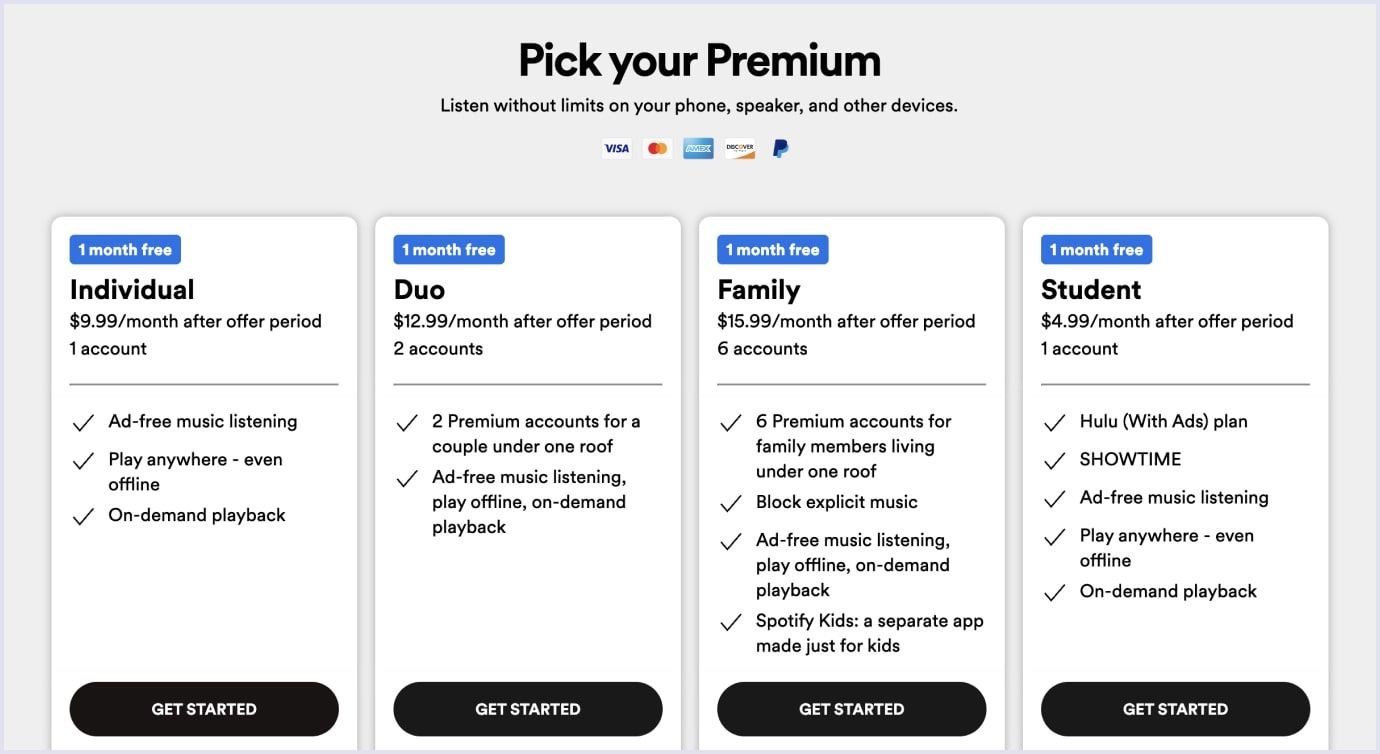
Source: Spotify
The huge advantage of the freemium model lies in the high conversion rate. The whole logic of this model relies on users who try using Spotify for free and then switch to the premium version.
At this point, the app also has you covered as they offer several plans like Duo, Family, and a Student plan with a 50% discount.
Subscription-based model: pros and cons
Pros
- Regular revenue. When you have a stable user base, monthly basis payments allow you to comfortably manage and analyze the app revenue as well as plan future updates.
- Effective user engagement. Offering users a free trial or discounts for longer subscriptions only inspires more people to subscribe.
- High flexibility. The ability to update prices, change subscription times, and pack it with different functionality makes this model versatile.
- Ability to rank higher in app stores. Thanks to the regular updates your app has to come up with, it can rank higher in terms of app store optimization.
Cons
- Needs for regular updates. With the app subscription model, users that pay for the premium functionality on a monthly basis need new content regularly. Accordingly, you will need to update the app or its content regularly.
- Free trial need. It’s doubtful new users will subscribe right away before familiarizing themselves with everything the app offers. Thus, you need to provide them with a free and cancellable trial. People will almost always try to find workarounds to access premium content without paying. Thus, it implies more time and expenses to figure out the breach and fix it.
In conclusion, subscription-based monetization can be an effective way to generate revenue from mobile apps by offering users access to premium features or content on a recurring basis. It can provide a reliable source of revenue over time while also fostering a sense of loyalty and engagement among users.
However, subscription-based models can also be more difficult to implement and require ongoing development and support to maintain. It's crucial to carefully evaluate the pros and cons of subscription-based monetization and consider how it fits into your overall mobile app monetization strategy.
IAPs (in-app purchases) model
This model takes advantage of offering an utterly free-to-download app that’s packed with many optional additions or contents. Having a microtransaction economy, apps with this monetization model are very profitable. These purchases can include a wide variety of things like filters for photo editing apps or consumables like “connections” on Upwork that freelancers need to apply for jobs.

Source: Upwork
Generally, despite being most popular in mobile games, this model can literally fit any type of app, including productivity, ecommerce, and other categories.
To increase the revenue and retention from this model, the market has already adapted to the average user’s needs and developed best practices.
Given that in-app purchases are optional and don’t have to affect regular usage, they still have to be useful for particular users. Offering a valuable update can skyrocket your app in terms of the cost-value ratio for users.
For instance, offering an ad-free experience or a premium functionality for a small amount of money may come in handy for many regular users.
Let’s take a look at how it works, using the example of Reddit, the most popular forum-based app. Here, people discuss various things in thematic communities.
The integration of in-app purchases here is fairly simple yet very popular – Reddit coins. People purchase them to award other people’s comments if they find them relevant, funny, or useful.
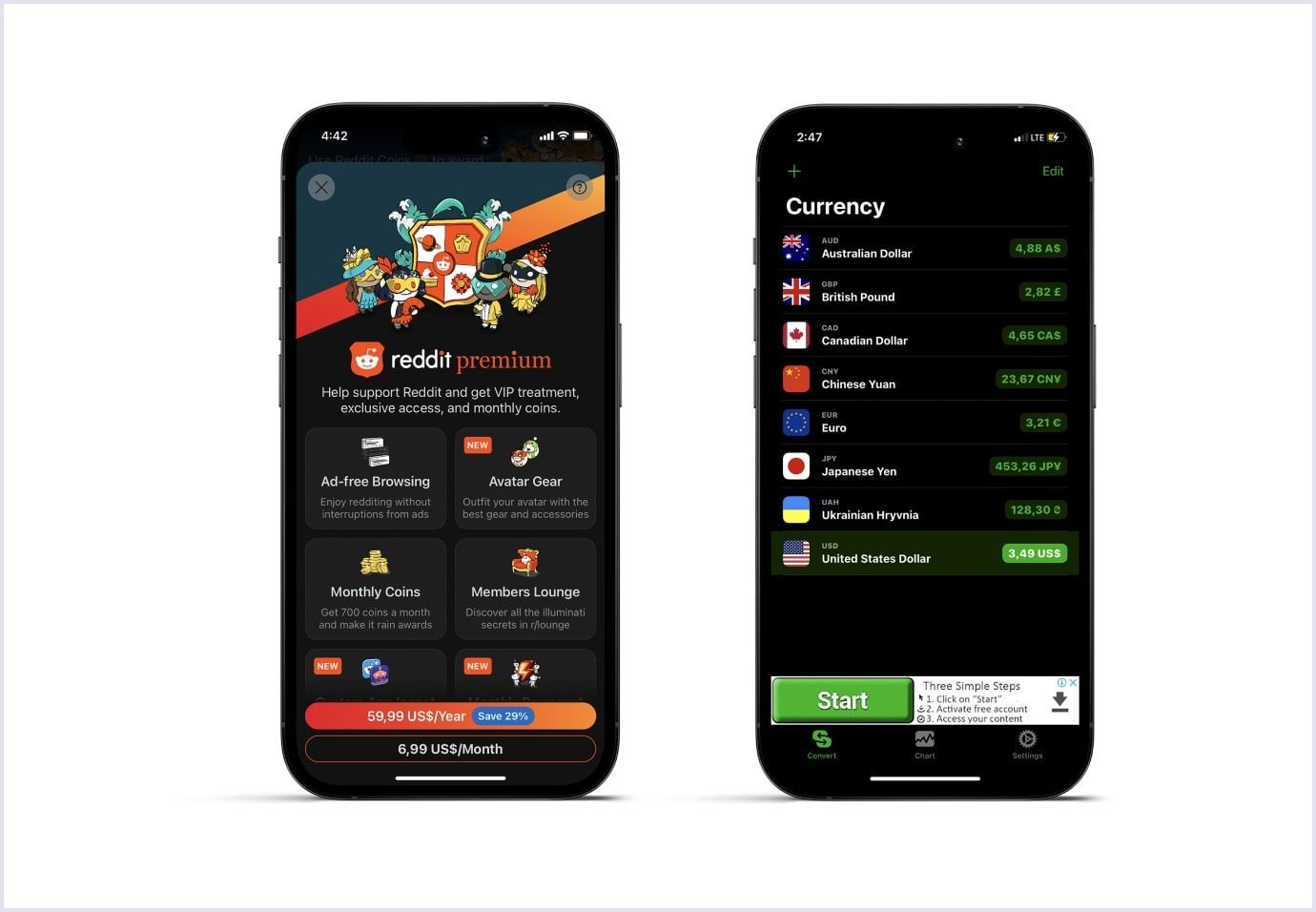
Source: Reddit
In-app purchases: pros and cons
Pros
- Simplicity. Thanks to modern development practices, in-app purchases are not only easy to implement, but they are also eye-pleasing, boasting animations and a friendly UI.
- Safe to use. Thanks to Google Pay and Apple Pay's presence on every smartphone, you no longer need to enter credit card details and approve the transaction in the banking application. The fewer users expose their private data, the less risk can take place.
- Direct payments. The conversion rate suffers when users get redirected to browser pages to proceed with the payment. The ability to pay right in the app makes in-app purchases a smooth and seamless operation.
Cons
- Strict admission process. Usually, it takes a week to see your app published on App Store or Google Play. Apps that feature purchases have to strictly obey the digital market’s rules. Accordingly, the admission process might last longer. Thus, making a transparent payment process is still an effort you have to consider.
- Extensive documentation. Everything that involves payments has to be clearly described to the user. This includes privacy and refund policies, user agreements, and others. Spoiler alert: We will cover them in detail later on.
Transaction apps and fees
Another revenue-rich monetization tools are apps with a financial aspect and the fees they charge. Basically, we use them more frequently than you might think: mobile banking, accommodation booking platforms, travel apps, or crypto exchanges.
Practically every app where transactions are involved earns its share for every purchase the user makes. As a result, this model allows you to generate app revenue as long as it is relevant and fulfilling in terms of user experience.
Let’s look at how it works on Kraken, a cryptocurrency exchange app.
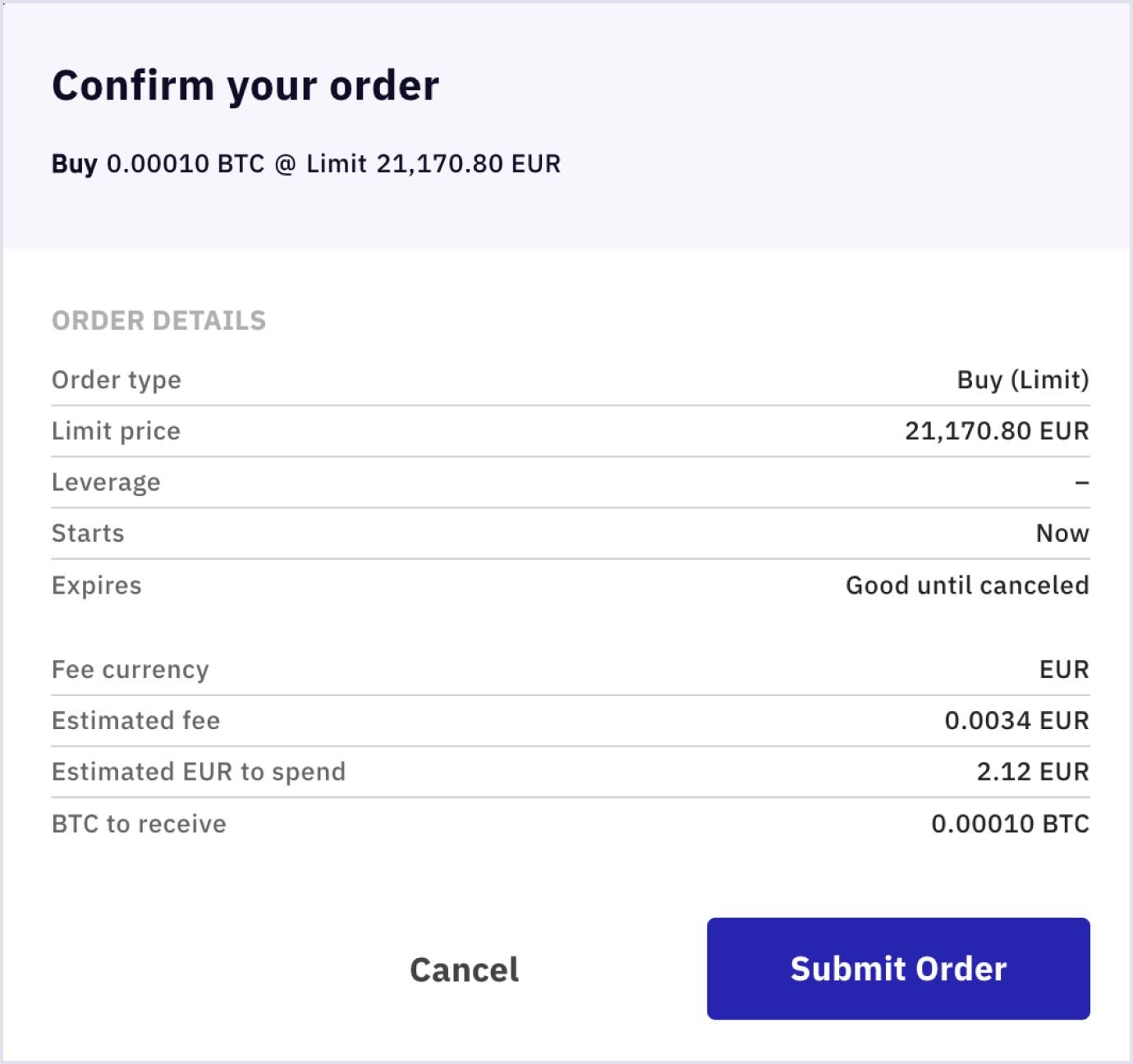
Source: Kraken
Crypto exchange app is where transactions move in thousands over a short span. Accordingly, the platform can quickly charge a small amount for every single transaction. Considering the Kraken documentation, their standard fee doesn’t even exceed half a percent.
Related reading: How to Create an NFT Marketplace?
Transaction apps: pros and cons
Pros
- Full control over pricing strategy. Applying your own fees lets you establish a well-managed pricing policy. Accordingly, it simplifies further planning and allows for estimating earnings.
- Simplicity. This monetization method is very straightforward. Making it transparent to the users is a must, as it increases trust in your product.
Cons
- Security risks. Integrating third-party services for payments requires additional thoughtfulness. Accordingly, investing in safety precautions is a decent idea. Also, you have to provide users with related functionality, such as two-factor authentication (2FA), backup codes, or various security checks.
- High entry threshold. To create reliable conditions for monetization and stable profit, transaction apps must have a large audience. Moreover, the audience's trust in the platform plays a big role. Thus, the high threshold of entry is the biggest drawback of this monetization model.
IAA (in-app ads)
IAA is a relatively simple yet very profitable mechanism. Generally, blank space in apps is sold to ad buyers to display what they want. With the extensive user base, even the presence of ads in the app already creates an additional revenue stream.

This popular app monetization strategy is quite common in gaming apps where users tend to spend the most time among others. Besides, they take more advantage of ads trying to interconnect them with in-game content.
In popular games like Candy Crush or Angry Birds, users can either purchase in-game currency or earn a little for watching an ad. This trick is especially popular, as both publisher and user benefit from it.
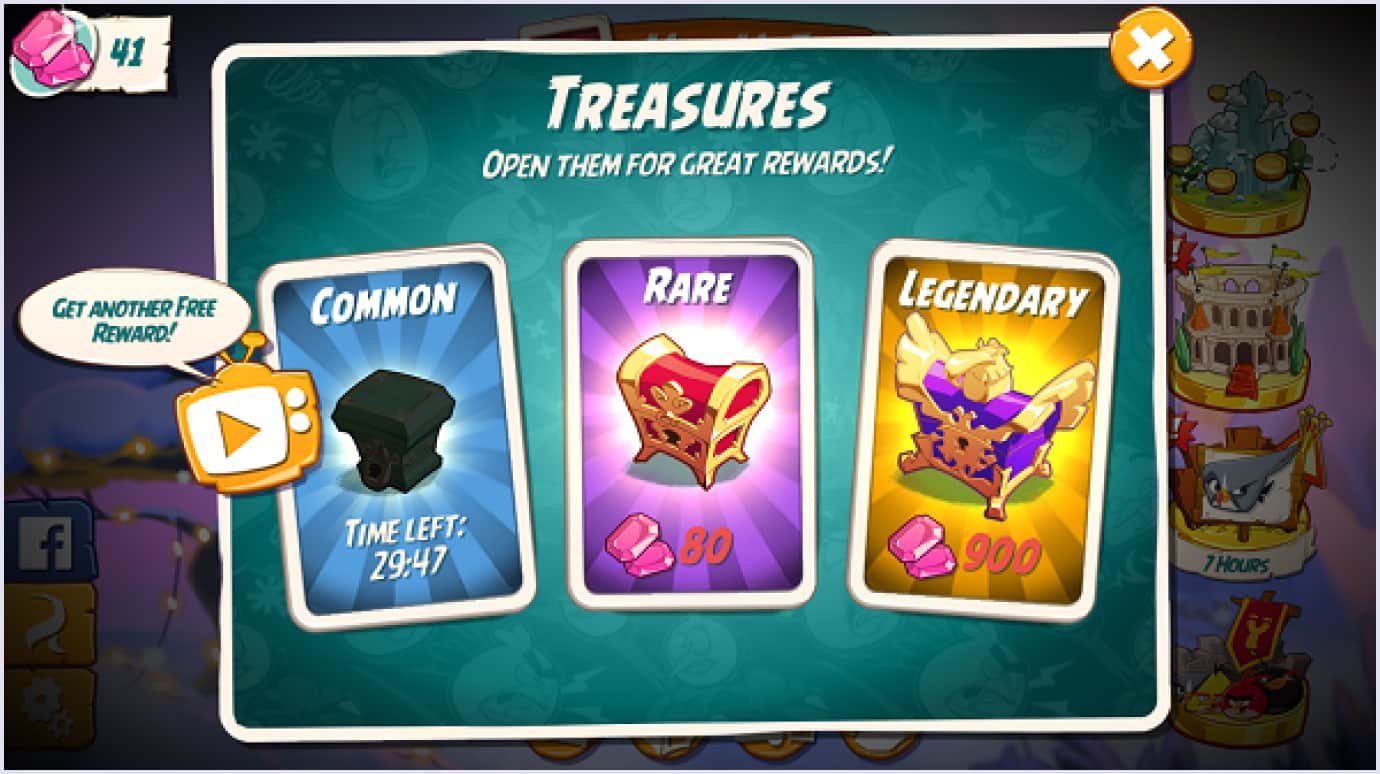
Source: Angry Birds 2
As this app revenue model evolved throughout the years, more types of ads appeared. Let’s cover the most popular of them.
Banner ads
These are the most controversial among all, as we all remember times when we hated them. However, thanks to Google AdMob, banner ads are easy to implement and use. They are not as popular as they were a few years ago, but some indie app developers still use them. You can also frequently see them in gaming apps.
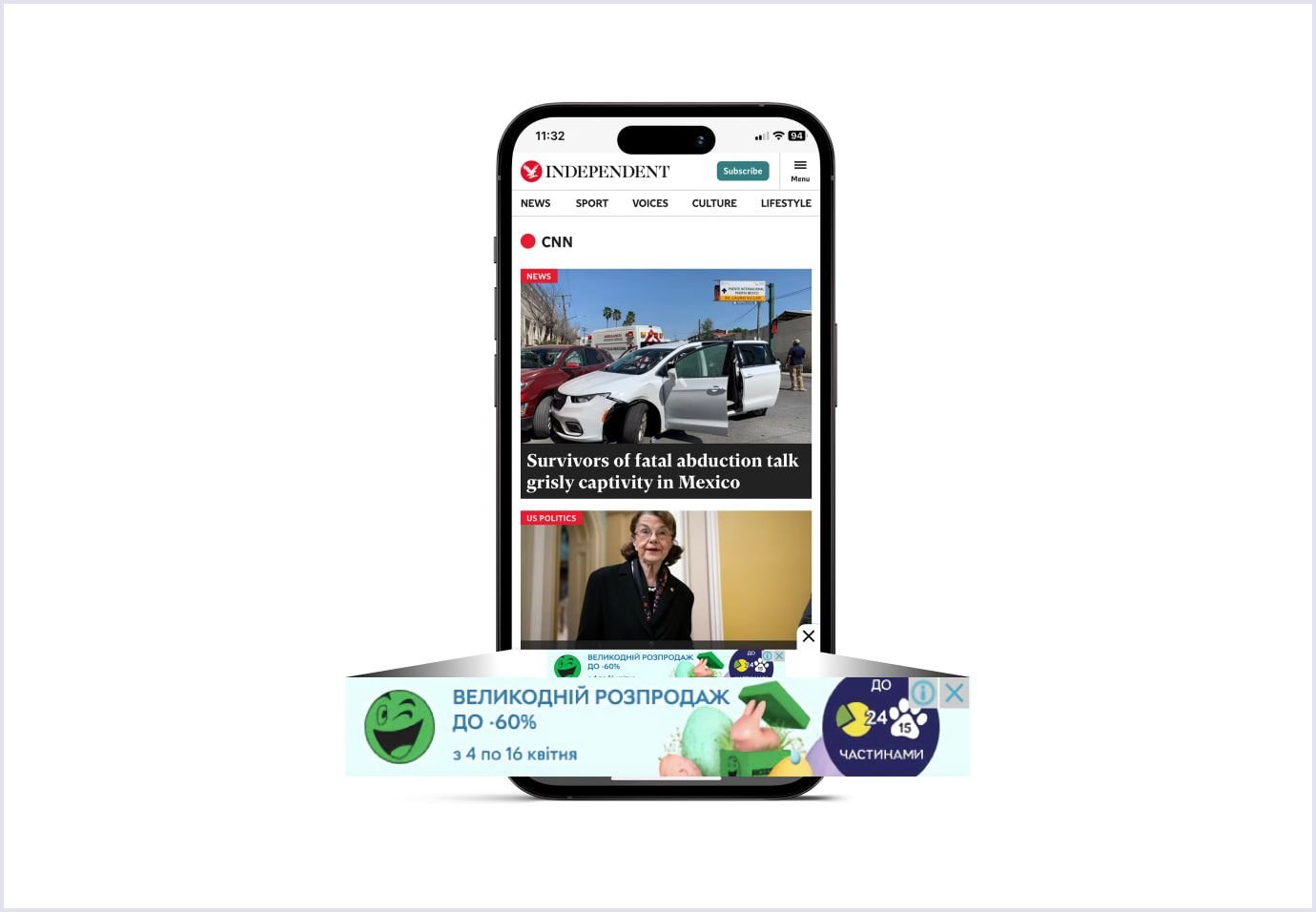
Source: The Independent
In the majority of cases, app banner ads don’t feel natural and, thus, may lead to a bad user experience. If you consider implementing them anyway, make sure they don’t cover essential UI parts and are not shown regularly so as not to annoy your customer.
Interstitial ads
This ad format can be seen as a video or a banner that pops up on the screen. Users then are given a choice to proceed with what is advertised or hit the exit mark and close it.
This in-app advertising is designed to be put between content the user consumes. To make it feel natural, interstitial ads have to be placed in the transition points, where users switch to another tab or screen.
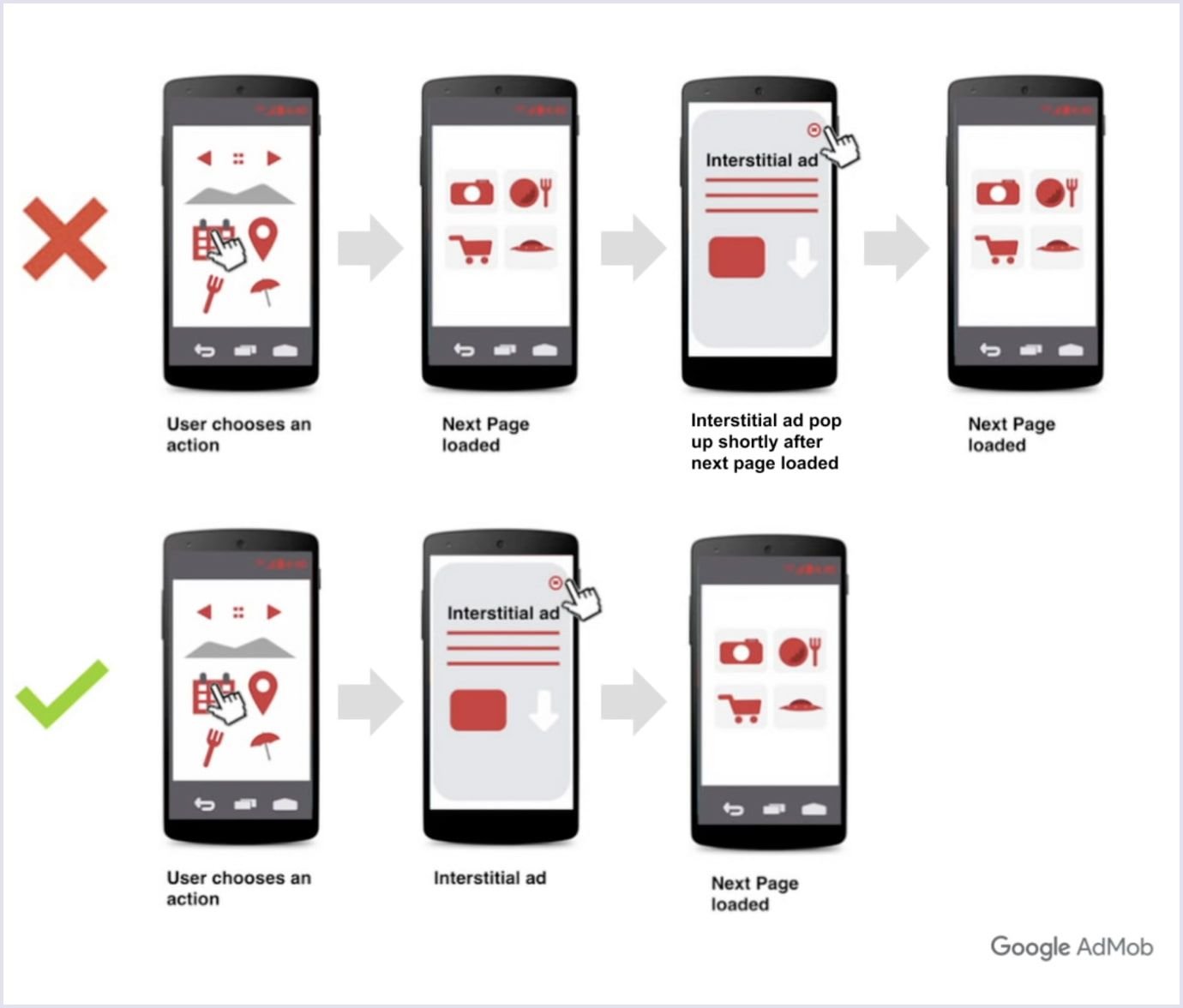
Source: Google AdMob Help
Google AdMob team advises being extra careful with the implementation so as not to interrupt the user flow and, thus, not worsen the user experience.
Native ads
Usually, native ads are part of the interface built by the development team without third-party integration. However, their mission is also different. They seamlessly blend into the app environment.
Native mobile app advertising is often the designer’s best choice as it is not disruptive and is the most natural among others. For instance, YouTube ads are greatly designed to fit the environment as they are literally embedded in some videos the user watches.
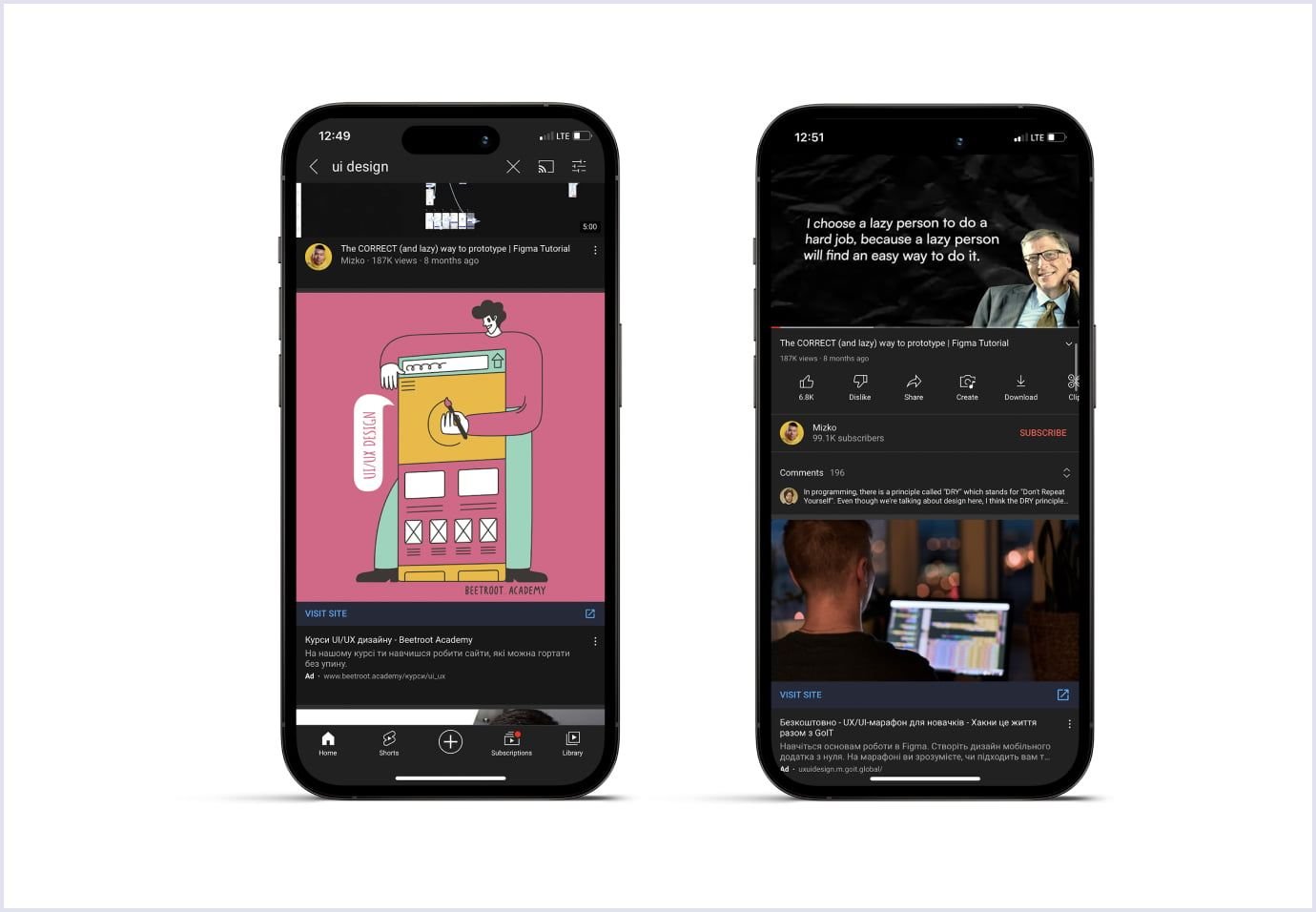
Source: YouTube
What’s more, Youtube ads usually appear at the beginning or the end of the video to not distract you.
Video ads
Most people get annoyed with ads. Full-screen ads are the most interruptive, as they lock any activity users can perform, forcing them to watch a 30-second video. Our experience shows that the best place to put video ads is when the user switches to another tab, adjusts settings, or is simply inactive for a few seconds.
The idea behind this is that advertisements must never interrupt the working session when mobile users do things they downloaded the app for.
Playable ads
These are relatively new to this list as they evolved from video ads. Playable ads are pretty common in mobile games, where similar products are advertised. When they play, users can not only watch but also try interacting with what it offers.
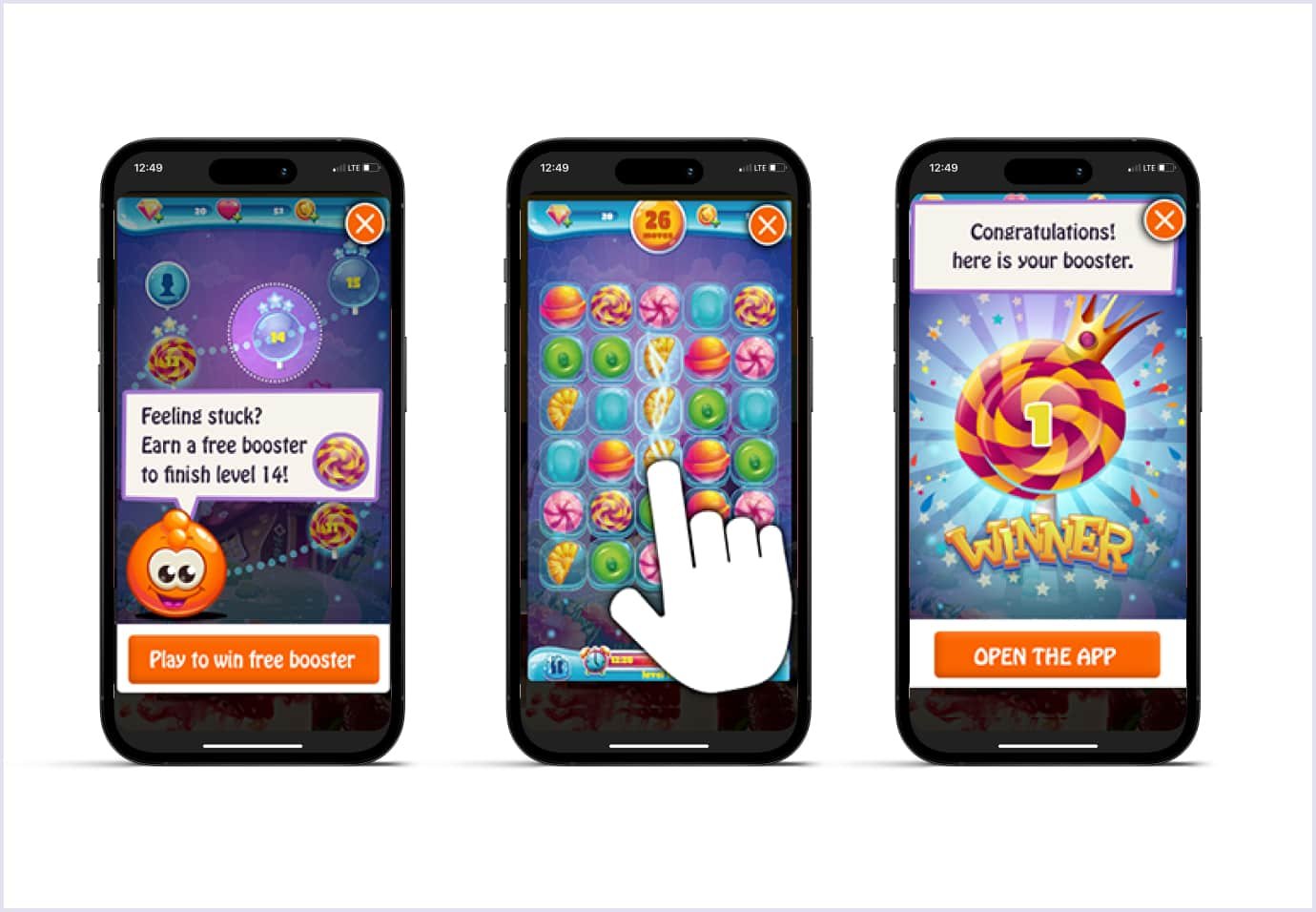
Source: Starloop Studios
In-app ads: pros and cons
Pros
- High user engagement rate. In-app ads are proven to be highly effective as they convert 3 times more users than mobile web ads.
- Targeted audience. Users choose to download your app, and adding relevant ads would be a successful decision to increase the click-through rate (CTR) and raise the app revenue level.
- Compatibility. In-app ads are optional and can be easily supplemented with other monetization means.
Cons
- Immersivity issues. Poorly chosen ad format easily disrupts user experience leading to uninstalls and bad reviews. However, this can be fixed by simply allowing people to get a premium version without ad integrations.
- Additional security needs. In case your app works with sensitive data, personal and banking details, it would not be wise to allow third-party ad integrations to access the app’s environment. Google AdMob, for example, is proven to be safe, yet many users won’t feel comfortable with ads anyways.
Choosing an app monetization strategy
Nowadays, this choice relies on proper planning. There’s no ultimate recipe for how to choose the right monetization model. However, there are three key things to consider to make a better choice.
Figure out your target audience
Considering what your app does, it will have its target audience. It means a particular group of people with similar occupations, ages, or interests. Do not hesitate to research your target audience’s interests extensively and see what else they might like.
Later, you will need to create customer personas. They are kind of fictional representations of your ideal users. They will help you understand your customers' motivations, preferences, and behaviors.
Make app and monetization mutually complementary
The app monetization strategy you choose has to supplement the functionality of your app. Simply put, ads you display have to correlate to the app’s idea to not ruin user experience and, thus, feel natural.
Research your competitors
With such market growth, competition is very high. Researching your potential rivals can not only reveal improvements you can make in your app but also show if the monetization models other app owners chose are effective. With such a variety of what apps can do, choosing the right model can be challenging, to say the least.
In this matter, Codica has got you covered with our product discovery service.
Why is it beneficial for you? Product discovery is our perfect way to validate your idea and find out ways how to strengthen it. Our team comprises numerous experts who cover various aspects of your future app, including UI/UX design, marketing, SEO optimization, and many others.

In the app monetization planning realm, you can rely on our expertise. We have already built many projects that involve different monetization strategies. The most prominent example would be Trade A Boat – an online marketplace for boats.
During the product discovery, we figured out that one of the best ways to monetize a marketplace is through ads. To not ruin the user experience, we made it an essential part of the marketplace, allowing users to create ads for goods they are going to sell.
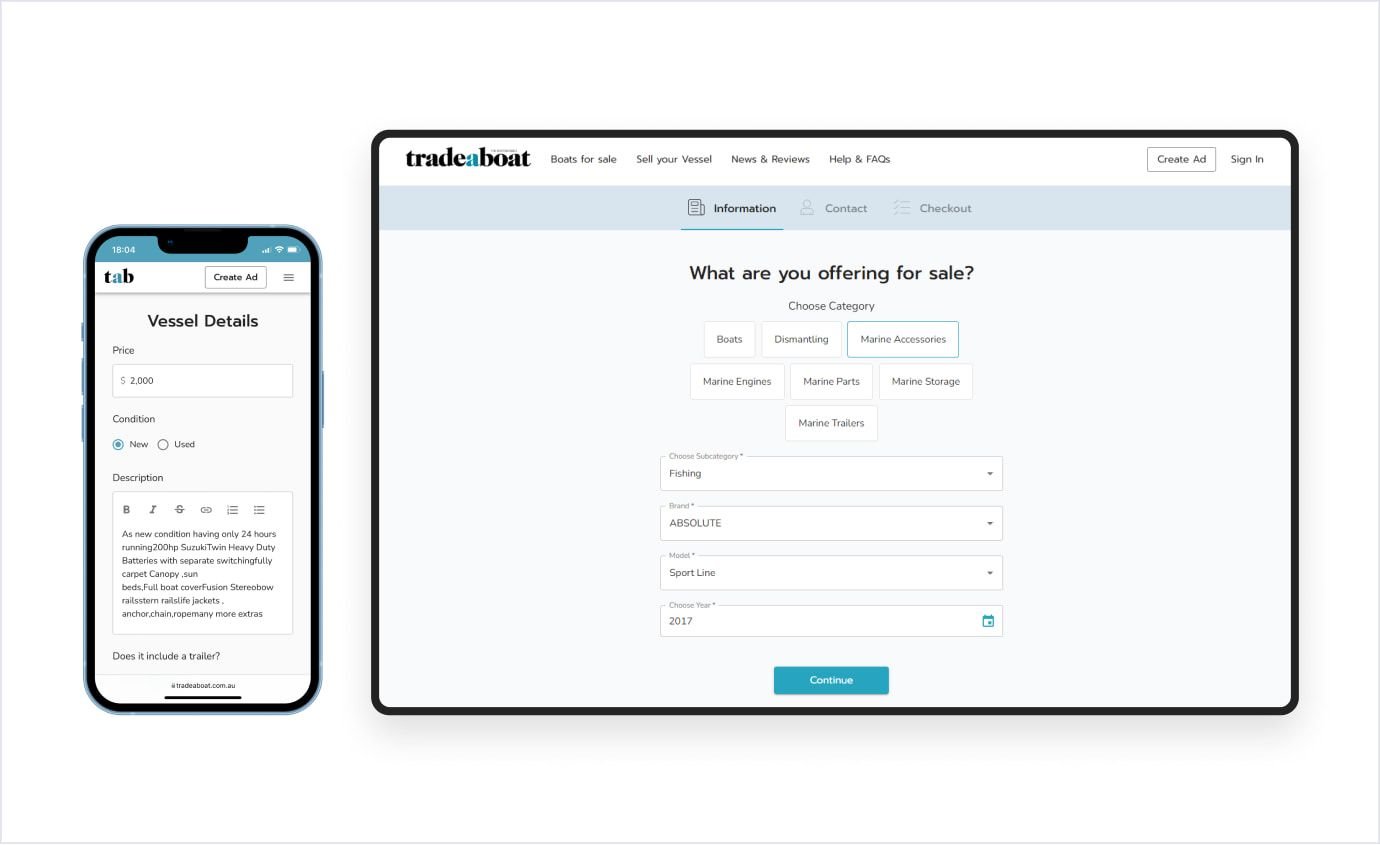
Such a solution benefits both advertisers and consumers, not to mention that the final product has exceeded all our expectations. As a result of our work, our client received not only a robust online marketplace but also a well-researched product. After we rebuilt it, Trade A Boat grew by 480% in terms of customer engagement.
You might also like: Designer’s Role in Discovery Phase
App monetization platforms
With an understanding of different app monetization models, let’s cover platforms. There are many of them, whereas the most popular ones are Unity Ads, InMobi, and AdMob. They usually serve as facilitators for implementing ads into your products. These mobile ad networks allow you to sell blank spaces in your app for advertisers programmatically.
When choosing the monetization platform to work with, the first thing you should look for is flexibility. The best app monetization strategies are those that are highly flexible and easily adjustable. Make sure the platform offers different ad formats because later on, you will be able to adapt them to your users’ needs and liking.
Another thing worth looking for is analytical support. If the platform can provide regularly updated data with different metrics, mobile marketing would be extremely beneficial. Tracking your app's performance is crucial to adjusting its growth, planning future updates, or making improvements in your app business model. Here are the three most popular platforms in this matter.
AdMob by Google
It is super user-friendly and open to app developers. It provides high-quality in-app advertising methods, including native, banner, interstitial ads, and many others.
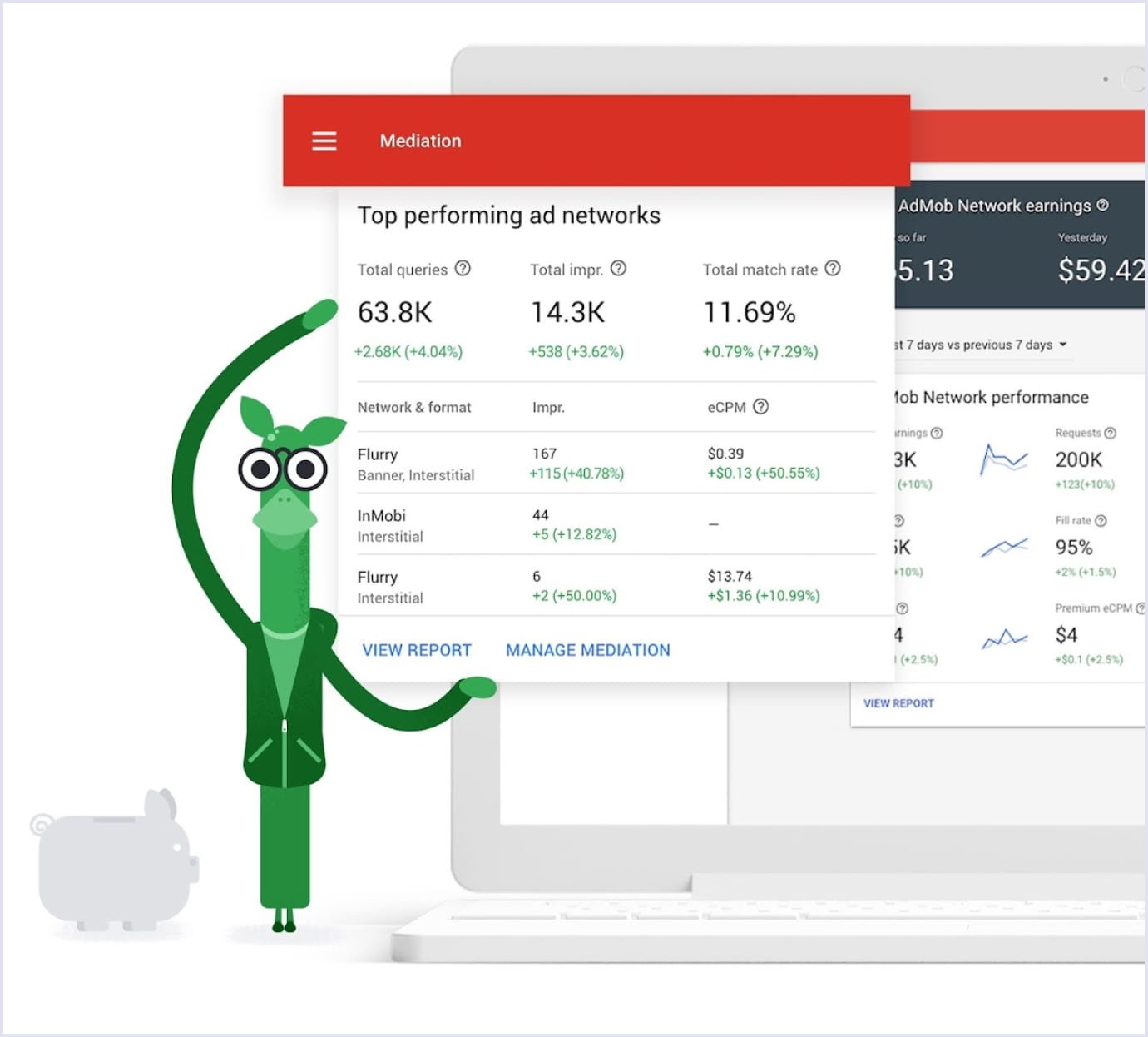
Source: Google AdMob
Its advanced analytics tools make AdMob even more valuable. It allows you to evaluate the ad revenue and whether your chosen app monetization method works as planned. Frankly, analytics is as important as app development itself. Let’s zoom in on it next.
Unity Ads
Primarily focused on mobile game advertising and provides a range of ad formats, including rewarded video ads, interstitial ads, and banner ads. Unity Ads also offers various targeting options, such as age, gender, location, device type, and app store data.
InMobi
Global mobile advertising and discovery platform that offers a range of ad formats, including native ads, video ads, interstitial ads, and banner ads. InMobi's platform uses machine learning algorithms to help advertisers target their ads to specific audiences based on a range of factors, including demographics, interests, behavior, and location.
Let’s shed more light on all three via the basic table-styled comparison.
| Feature | Unity Ads | InMobi | AdMob |
| Available ad formats | Rewarded videos, interstitial and banner ads | Native, video, interstitial, banner and carousel ads | Banner, interstitial, rewarded video, native and banner ads |
| Aspects the platform can target | Age, gender, location, device type, app store data | Demographics, interests, behavior, location | Location, demographics, devices, user interests, app categories, custom targeting |
| Minimum payout | $100 | $50 | $100 |
| Supported platforms | iOS, Android, Unity game engine | iOS, Android, Unity game engine | iOS, Android, Unity game engine, web |
Essential metrics on the analytical side of the app
The analytical side of monetization means strongly involves app marketing. It highly relies on data, which, luckily, modern apps provide over and above. Understanding the variety of monetization models and add types is only one side of the coin.
Another one lies in correctly understanding the concepts and adequately measuring the effectiveness of the model you chose.
Nowadays, dozens of metrics cover different areas of app marketing, i.e., revenue stats, user engagement, app store optimization, installation rates, and many others. So what are the main marketing metrics, and why should you care about them?
App metrics are the access point that lets you influence the app’s performance and adapt it to modern trends. With their help, you can answer the most common questions about how to get more app downloads, make users spend more on in-app purchases, or spend more time in the app.
Here is how App Store Connect lets publishers see the app’s performance.
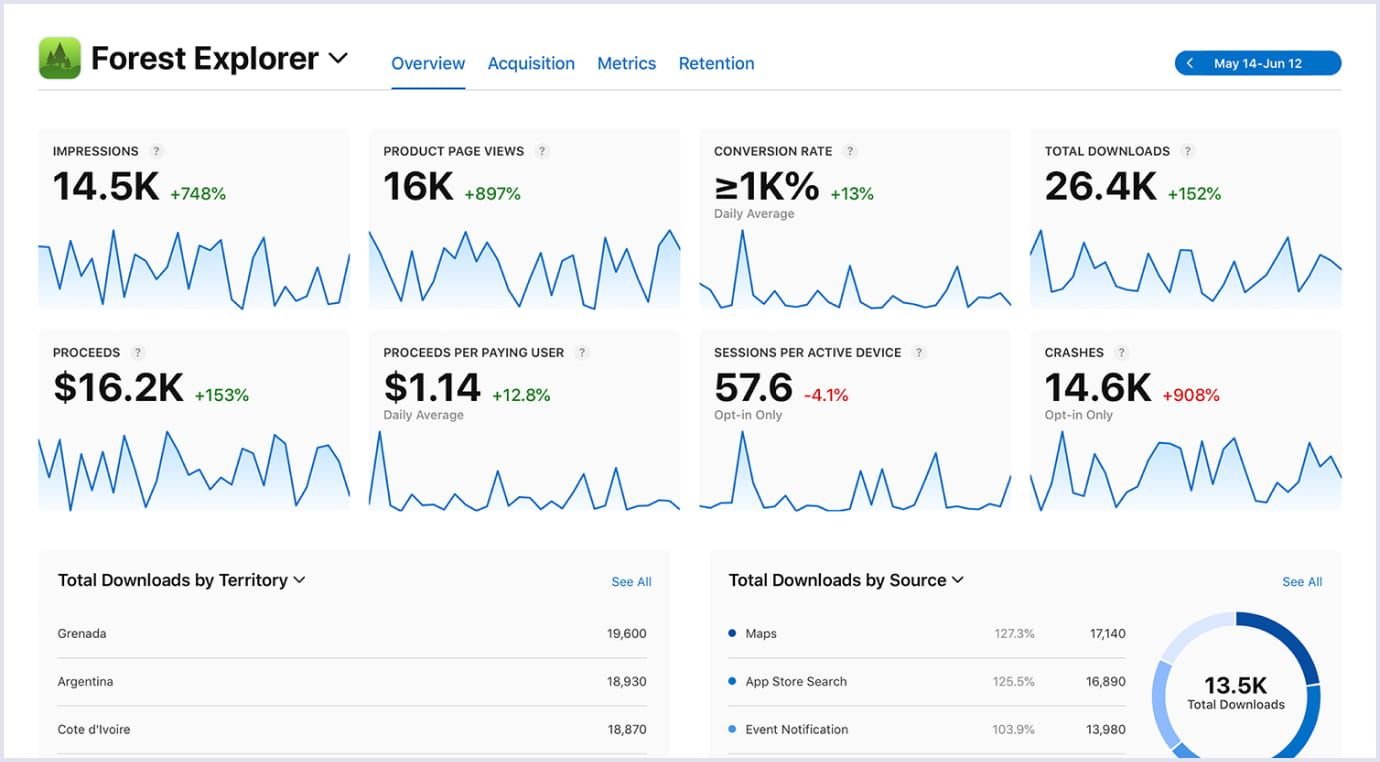
Source: Apple Developer
App stickiness
This metric calculates how sticky and engaging your app is. Marketers calculate it based on the daily active users (DAU) and monthly active users (MAU). The calculation is relatively simple, given that you simply need to divide DAU by MAU. Nevertheless, this ratio is pretty accurate.
It’s worth noting that there’s no one-size-fits-all answer to what percentage of app stickiness is considered okay or not enough, as it varies depending on the app category and business goals. However, as a general rule, an app with a stickiness rate of 20% or higher is considered good, and a rate of 30% or higher is excellent.
Lifetime value (LTV)
This estimate figures out how much revenue is generated per user in the whole span from installation up to date. LTV is particularly useful to define future marketing plans, upcoming sales, or potential discounts on the most trending goods users purchase. Here’s how to calculate it.
Choose the time period for which you want to calculate the LTV.
Determine the average amount of money the customer spent during this time period.
Determine the number of purchases made by the customer during the time period.
Multiply the average value of the purchase by the number of purchases made during the time period to calculate the customer's total revenue.
Determine the average time span the customer continues to buy from you.
Next, use the following equation:
LTV = (customer's total revenue) x (customer's average lifespan)
For example, if a customer spends an average of $100 per purchase and makes 10 purchases over a two-year period, their total revenue would be $1000. If their average lifespan as a customer is five years, their LTV would be:
LTV = $1000 x 5 = $5000
This means that the customer's LTV is $5000, which is the estimated total revenue that the customer will generate for your business over their entire relationship with your company.
Retention rate
Retention rate calculates the number of active and returning mobile users over a specific time period. It is often defined as a high-level metric, as it covers only major numbers without considering single-user behavior patterns. Still, it is convenient to evaluate the user experience.
The retention rate is calculated fairly simply. Here’s how you do it.
Set the time period you want to calculate the customer retention rate for.
Figure out the number of customers at the beginning of the time period.
Figure out the number of customers at the end of the time period.
Figure out the number of customers you acquired during the time period.
Calculate the customer retention rate using the following formula:
Subtract the number of customers acquired during a specific time period from the total number of customers at the end of that period. Then, divide the result by the number of customers at the beginning of the time period. Finally, multiply the quotient by 100 to express it as a percentage.
Let’s look at a practical example. If you had 100 customers at the beginning of the year, gained 20 new customers during the year, and ended the year with 90 customers, your customer retention rate would be:
((90 - 20) / 100) x 100 = 70%
This means that you retained 70% of your customers over the course of the year.
Essential things to take care of
In the app business, you have to pay attention to numerous small details that can affect the bigger picture. Apart from app monetization models and in-app advertisement types, there are plenty of other things to consider.
Regional pricing
People undoubtedly enjoy seeing sales, personal, and “last chance” offers. However, average price points vary in different countries and regions.
To establish a beneficial pricing model, you need to pay attention to 3 main factors:
- Local sales trends;
- Local purchasing capabilities;
- Currency exchange rates.
Apple’s pricing system, which is shared over their whole digital market’s ecosystem, is a neat example.
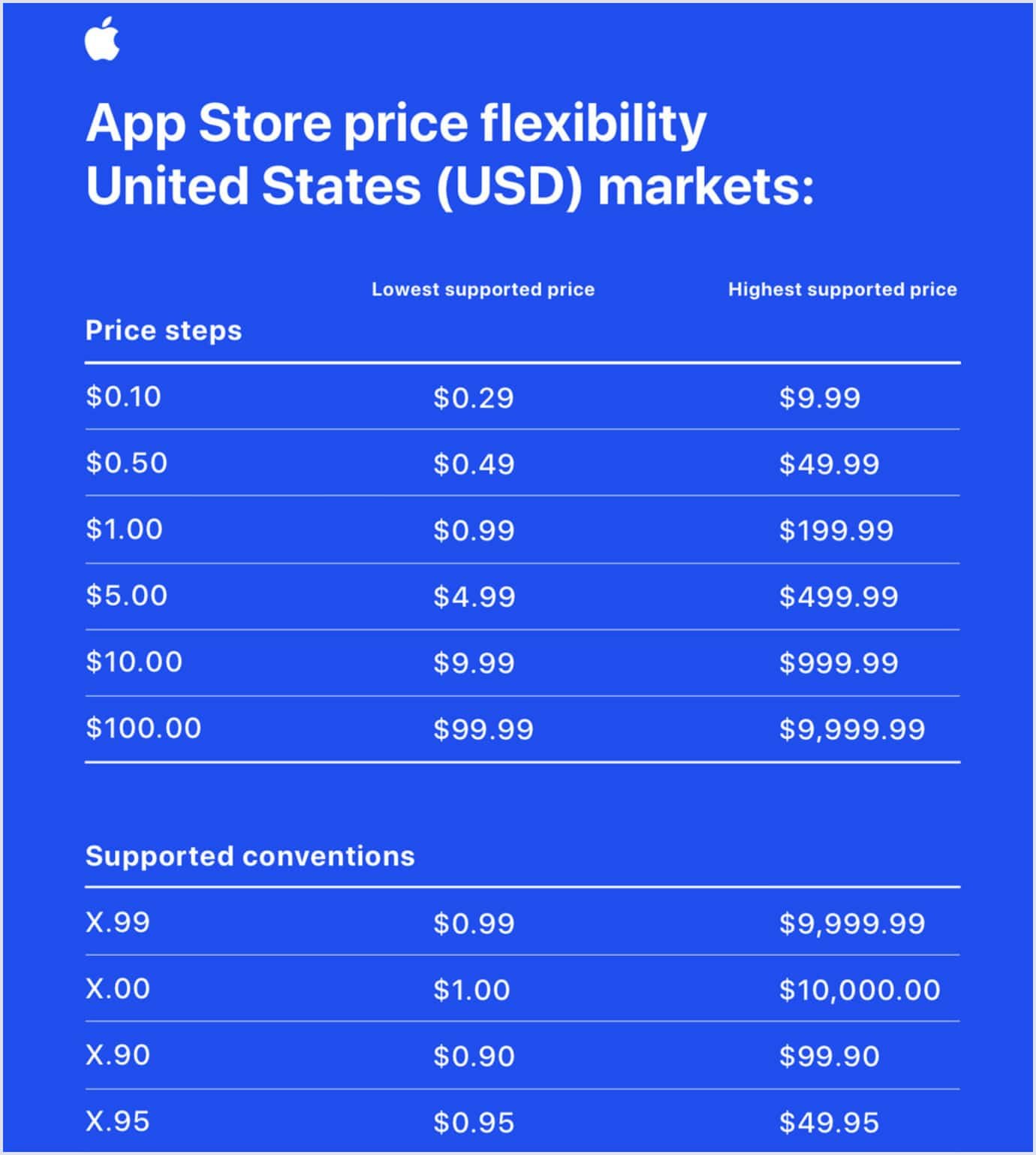
Source: Apple Developer
This system dramatically simplifies pricing strategy for app developers and makes apps affordable for users from different countries.
If your app is planned to be distributed worldwide, regional pricing is a vital thing to consider. In some countries, $20 for a subscription is pocket change; in others, it’s enough to buy food for a week.
Privacy policy
In the 2010s, the world was shaken by the scandal involving Facebook collecting data of nearly 80 million users without their consent. This has been a great lesson for many product companies to put user privacy first. Ever since, all apps are obliged to have a clear privacy policy describing what data they collect and why they need it.
Privacy policy requirements differ based on the functionality of the app. Nevertheless, if your app involves purchases and works with sensitive data, documents, bank details, and others, make sure the privacy policy is always up to date and easily accessible within the app.
Besides, without a good privacy policy, your app most likely won’t even pass the admission process to both the AppStore and Google Play Market.
Read also: Ultimate Guide to Web Application Security
Reviews
Ratings and reviews of your app are the best sources for inspiration and further improvements. There already are many beaten paths, yet it’s still important to figure out your perfect app recipe. Some monetization models or ad formats may not suit your app, and you won’t even notice.
This approach works with many other things in development. It became a classic example for app developers to check the app along and across and still fix things users find. Thus, never omit to respond to reviews and note what people wish to see in the app.
Besides, high ratings and many reviews only assist you. They have a huge impact on app store optimization (ASO). For instance, both Google Play and Apple App Store tend to rank higher for those apps that have more positive reviews.
You can also inspire your new users to leave a review. The application of this feature is very wide. For example, you can show a pop-up with suggestions once they finish a level in the game, perform a purchase in the marketplace, or complete a task in the to-do app.

Source: Stock Analyzer
Bottom line
At this point, there is no doubt app monetization strategy is a highly complex subject. After covering various topics that include different monetization models, types of ads, and other important points, we are sure that mobile app monetization is definitely broader than you thought.
However, we sincerely hope our comprehensive guide sheds more light on this subject. Thanks to our expertise in both mobile app development and marketing, we feel confident speaking about the topic.
Furthermore, we provide services that cover many growth aspects. For instance, we can easily test and validate your idea with our product discovery service. Later on, we can cover the whole building process from scratch with our mobile app development service. We would love to work on new exciting projects. If you have an idea – don’t hesitate to contact us.

